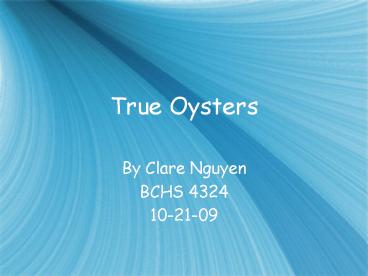True Oysters - PowerPoint PPT Presentation
1 / 12
Title: True Oysters
1
True Oysters
- By Clare Nguyen
- BCHS 4324
- 10-21-09
2
True Oysters
- Found in seas, bays, estuaries, and near the
shore - Grow on oyster beds
- Eat detritus and phytoplankton
- Shells have rough exterior feel and vary in shape
- Bivalve mollusc with uneven valves
- Left-sided(sinistral) attachment
3
True Oysters
- Oysters are called true if they have
antimarginal ribs. - True oysters belong to the family Ostreidae.
4
Kindom Animalia
Phylum Mollusca
Class Bivalvia
Subclass Pteriomorphia
Order Ostreoida
Family Ostreidae
Genus Crassostrea Dendostrea Lopha Ostrea Os
treola Saccostrea Striostrea
5
Dendostrea frons
Crassostrea gigas
Lopha cristagalli
Ostrea edulis
Ostreola equestris
Striostrea circumpicta
Saccostrea cuccullata
6
True Oysters
- Phylogenetic studies by Foighil and Taylor (2000)
- Broadcast spawners subfamily Crassostreinae
(Crasssostrea and Striostrea) - Brooders subfamilies Lophinae (Dendostera, Lopha,
and Alectryonella ) and Ostreinae (Ostrea)
7
Foighil, D.O., Taylor, D.J., 2000. Evolution of
Parental Care and Ovulation Behavior in
Oysters. Molecular Phylogenetics and
Evolution. 15, 301-313.
8
Foighil, D.O., Taylor, D.J., 2000. Evolution of
Parental Care and Ovulation Behavior in
Oysters. Molecular Phylogenetics and
Evolution. 15, 301-313.
9
- Klinbunga, A., Khamnamtong, B., Punglarp, N.,
Jarayabhand, W.Y., Menasveta, P. 2005. Molecular
Taxonomy of Cupped Oysters (Crassotrea,
Saccostrea, and Striostrea) in Thailand Based on
COI, 16S, and 18S rDNA Polymorphism. Marine
Biotechnology. 7, 306-317.
10
True Oysters
- Shilts et al. constructed phylogenetic trees
based on markers from mitochondria (16S and
cytochrome c oxidase I) and nucleus (first
internal transcribed spacer). - Proposed dissolution of genus Ostreola and
placing all of the taxa under the genus Ostrea. - Proposed the dissolution of the genus Cryptostrea
for the Cryptostrea permollis to belong under the
genus Ostrea.
11
Questions
- Whether phylogenetic trees should be constructed
based on morphology or molecular studies or both? - Are Ostreidae really monophyletic as stated in
one of the articles ? - Should some genus be abolished and reorganized
under a preexisting genera? - The level of genetic diversity among the species
within each taxa?
12
References
Abbott, R.T., Morris, P.A., 1995. A Field Guide
to Shells. New York, NY Houghton
Mifflin Company. Foighil, D.O., Taylor, D.J.,
2000. Evolution of Parental Care and Ovulation
Behavior in Oysters. Molecular Phylogenetics and
Evolution. 15, 301-313. Hautmann, M., 2006. Shell
morphology and phylogenetic origin of
oysters. Palaeogeography, Palaeoclimatology,
Palaeoecology. 240, 668671. Klinbunga, A.,
Khamnamtong, B., Punglarp, N., Jarayabhand, W.Y.,
Menasveta, P. 2005. Molecular Taxonomy of Cupped
Oysters (Crassotrea, Saccostrea, and Striostrea)
in Thailand Based on COI, 16S, and 18S rDNA
Polymorphism. Marine Biotechnology. 7,
306-317. Márquez-Aliaga, A., Jiménez-Jiménez,
A.P., Checa, A.G., Hagdorn, H., 2005.
Early oysters and their supposed Permian
ancestors. Palaeogeogr. Palaeoclimatol. Palaeoeco
l. 229, 127136. Shilts, M.H., Pascual, M.S.,
Foighil, D.O., 2006. Systematic, taxonomic
and biogeographic relationships of Argentine
flat oysters. Molecular Phylogenetics
and Evolution. 44, 467-473. Wye, K.R., 1991. The
Encyclopedia of Shells. New York, NY Quarto
Publishing.































